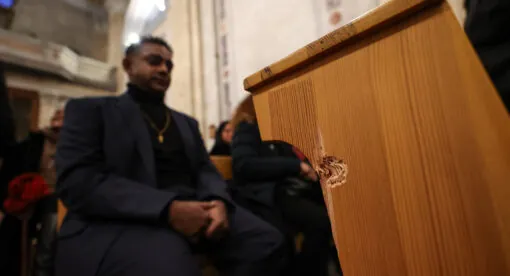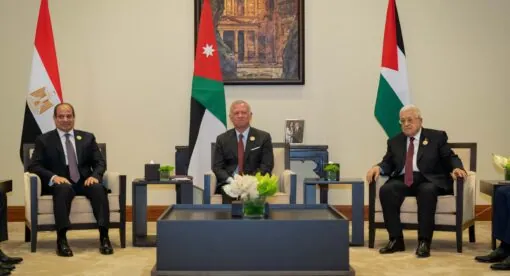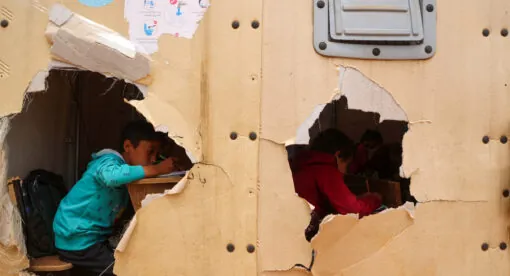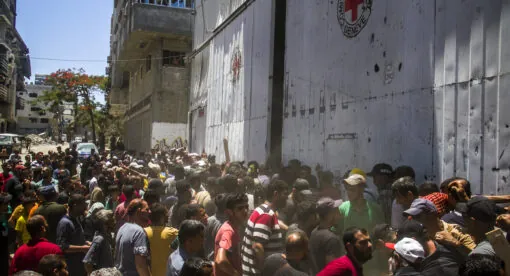The Weekly Forecast Monitor is a forward-looking assessment of geopolitical dynamics shaping our world. To get more in-depth analysis of these issues and learn more about analytical products from New Lines Institute — including simulations, training sessions, and forecast reports — contact us at [email protected] and visit https://newlinesinstitute.org/analytical-products/. Download PDF version.
Global Hotspots
The Global Hotspot Tracker examines the outlook for key geopolitical hotspots around the world. (Go to the Global Connectivity Tracker)
Middle East
Summary – Tensions in the Middle East continued to trend toward a military escalation scenario, as Israel took “tactical control” of the Philadelphi Corridor. Israel continued its offensive across Gaza and an Israeli airstrike in Rafah set fire to a tent camp, killing at least 45 people. The U.S. and UK struck al-Houthi targets in Yemen. After the latest round of cease-fire talks in Paris, Israel submitted an updated hostage release deal to the U.S., Egypt, and Qatar.
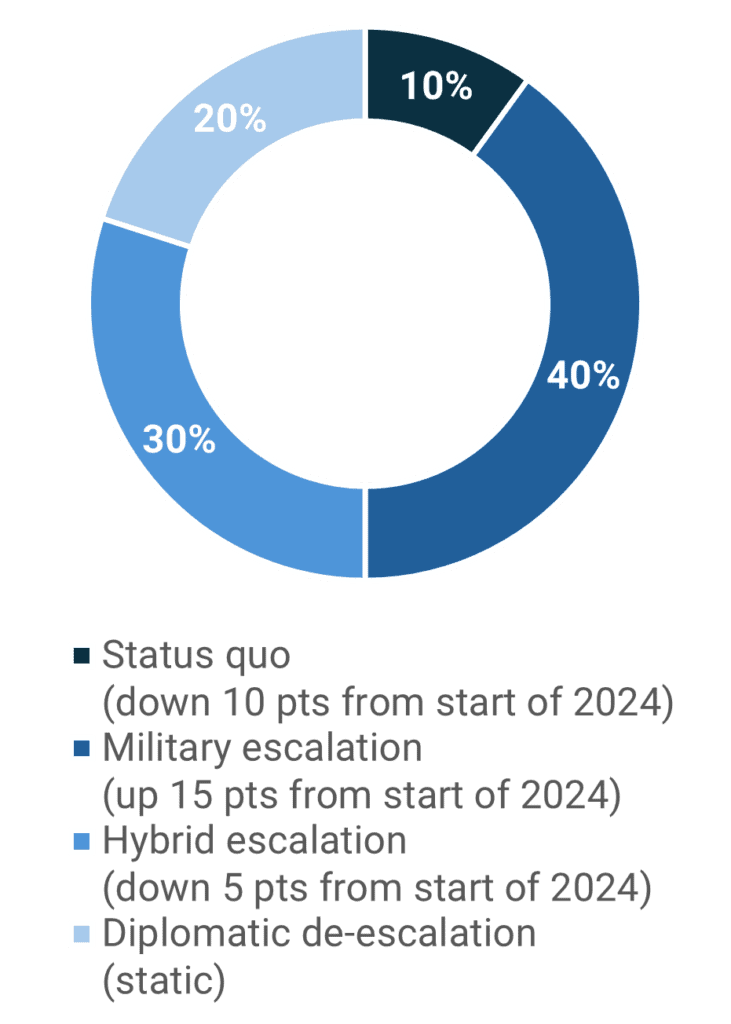
Military escalation scenario
- The IDF took “tactical control” over the Philadelphi Corridor.
Risk level – high - Israeli and Egyptian troops exchanged fire near the Rafah border crossing, resulting in the death of an Egyptian soldier.
Risk level – high - At least 45 people were killed after an IDF strike on a tent camp in Rafah. Days later, at least 21 people died in a similar IDF strike.
Risk level – high - The U.S. and UK carried out airstrikes against al-Houthi targets in Yemen. The al-Houthi group claimed to have launched retaliatory strikes targeting the USS Eisenhower.
Risk level – medium
Hybrid escalation scenario
- Spain, Norway, and Ireland formally recognized a Palestinian state. Israel condemned the action.
Risk level – medium
Diplomatic de-escalation scenario
- Israel submitted an updated cease-fire proposal, stating it was “flexible” about the number of hostages released in the first phase of the deal.
Opportunity level – low - Chinese President Xi Jinping said China supports an independent Palestinian state and wants to organize a peace conference to achieve that outcome.
Opportunity level – low
Russia/Ukraine Conflict
Summary – The Russia-Ukraine conflict is trending toward military and hybrid escalation scenarios as Russia continued drone and missile strikes against Kharkiv and other Ukrainian regions while Ukraine targeted Crimea and Russia proper with its own strikes. U.S. and EU leaders authorized Ukraine to use the weapons systems they have provided to attack military targets inside of Russia in a limited capacity. The EU ramped up sanctions against Russia, while Ukrainian President Volodymyr Zelenskyy appealed to U.S. and Chinese leaders to attend a peace summit in Switzerland in June.
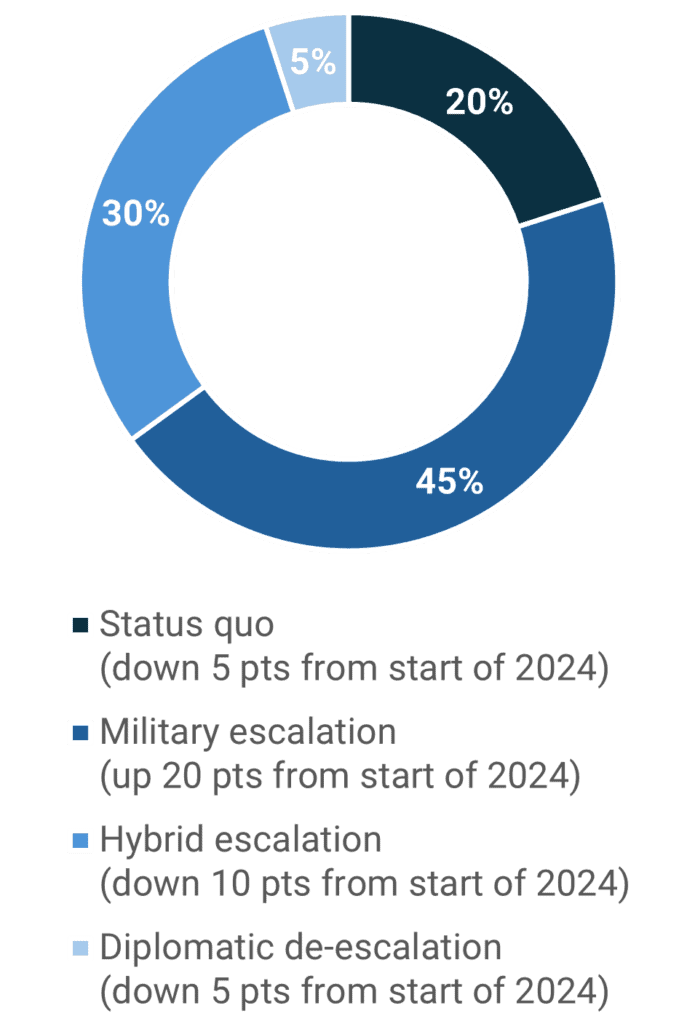
Military escalation scenario
- U.S. and EU leaders will allow Ukraine to use weapons that their countries provided to it to strike military targets inside Russia. President Joe Biden limited the deployment of U.S.-supplied weapons to the region near Kharkiv.
Risk level – medium - France indicated it would send military trainers to Ukraine in a move that could be announced next week during Zelenskyy’s visit to Paris.
Risk level – medium - Poland announced it would fortify its border with Belarus, while six NATO countries announced they would be building a “drone wall” to protect against attacks by Russian unmanned aerial vehicles.
Risk level – low - Ukraine has established “combat control” of areas of Kharkiv that were subject to a Russian incursion, while Russia continued missile and drone attacks in the region and ramped up such strikes across regions in western, central, and southern Ukraine.
Risk level – low
Hybrid escalation scenario
- The EU imposed “prohibitive” duties on grain imports from Russia in a bid to stop Russia from exporting grain harvested from territory seized from Ukraine.
Risk level – low - The EU added 20 additional Russians to its sanctions list for human rights violations.
Risk level – low
Diplomatic de-escalation scenario
- Zelenskyy appealed to U.S. President Joe Biden and Chinese President Xi Jinping to attend a peace summit on the Ukraine conflict in Switzerland in June, stating that their absence would amount to “appeasing (Russian President Vladimir) Putin.”
Opportunity level – low - Ukraine and Russia exchanged 150 prisoners of war, facilitated by mediation by the United Arab Emirates.
Opportunity level – low
U.S./China/Indo-Pacific
Summary – Tensions in the Indo-Pacific trended toward a hybrid escalation scenario, as China announced new export controls on aerospace and gas turbine technology as well as the removal of preferential tariffs on select imports from Taiwan. China, South Korea, and Japan held a trilateral summit where they agreed to continue discussion on a three-party free trade agreement.

Military escalation scenario
- The Philippines protested after China announced its annual fishing ban in contested waters of the South China Sea will last four months this year. China made the announcement as it deployed its largest coast guard vessel to the area.
Risk level – medium - North Korea said it fired nearly 20 short-range ballistic missiles off its east coast.
Risk level – low - China said its two-day military drills around Taiwan last week accomplished their objective but that it would take more action if provoked.
Risk level – low
Hybrid escalation scenario
- China announced new export controls on aerospace equipment and gas turbines that will go into effect on July 1. The top importers of the Chinese-made products are the U.S., Germany, and Saudi Arabia.
Risk level – low - Chinese SVOLT Energy Technology announced it would reduce electric vehicle (EV) battery production in Germany, in response to falling European EV sales due to increased tariffs on Chinese-made EVs.
Risk level – low - China will remove preferential tariffs on 134 imports from Taiwan.
Risk level – low - China announced a $47 billion package to support its domestic semiconductor industry and counter U.S. restrictions on Chinese advanced technology.
Risk level – low - North Korean leader Kim Jong Un pledged to continue the country’s space reconnaissance program after a failed attempt to launch its second reconnaissance satellite.
Risk level – low
Diplomatic de-escalation scenario
- China, Japan, and South Korea participated in a trilateral summit. Both U.S. partners agreed to continue dialogue and resume talks on a three-party free trade agreement.
Opportunity level – medium
Global Connectivity
The Global Connectivity Tracker examines the sectoral impact of geopolitical dynamics on key themes like the global energy/climate transition, trade, and technology. (Go to the Global Hotspot Tracker)
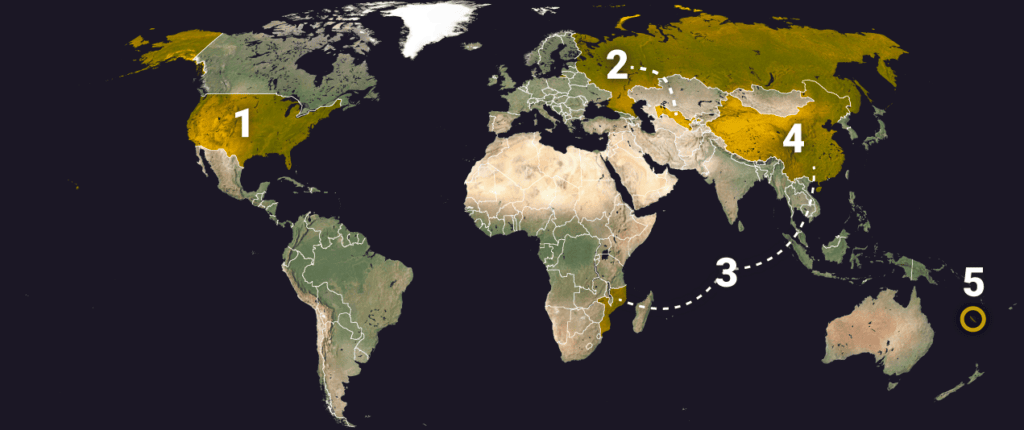
Energy/Climate
- United States: Rare Earths
What happened: The United States is expected to achieve its aim of having a domestic supply chain of rare earth elements for defense use by 2027.
Significance/Outlook: China dominates the rare earth elements supply chain, making its export vulnerable to geopolitical disruption. The United States wants to reduce reliance on Chinese rare earth elements, as most of the rare earth minerals in the world are extracted and processed in China. The rare earths supply chain includes mining and concentrating raw materials, refining them to oxides, and using those to make magnets crucial to green energy applications. China controls 91% of refining, 87% of oxide separation, and 94% of magnet manufacturing. The U.S. has sought to source these minerals from alternative and reliable suppliers, including close allies like the UK, Canada, and Australia.
Opportunity level – medium - Russia/Uzbekistan: Nuclear Power
What happened: Russia is planning to construct as many as six small-scale nuclear reactors in Uzbekistan.
Significance/Outlook: These small nuclear reactors, used for power generation, will help ensure Uzbekistan’s energy security and ability to achieve sustainable growth. Recently, Uzbekistan experienced natural gas shortages and electricity outages due to increased energy needs. The demand for electricity in Uzbekistan is expected to double by 2050. For energy system stability and economic growth, Uzbekistan needs additional baseload power and renewable energy capacity. Compact nuclear reactors may be built faster than large-capacity reactors and can be expanded to meet a country’s needs.
Opportunity level – low/medium - China/Mozambique: Oil
What happened: The China National Offshore Oil Co (CNOOC) has signed a deal to explore and produce oil and natural gas in five offshore blocks in Mozambique.
Significance/Outlook: The exploration will last four years with CNOOC and Mozambique’s state energy company, ENH, operating together in the offshore blocks. CNOOC will operate the exploration and development phases, while ENH owns the non-operating interests. Mozambique has a significant potential for LNG production and possesses a natural gas reserve estimated at around 180 trillion cubic feet. Political instability in Mozambique, however, stands as a challenge to further development. Despite that, other companies, including Exxon and ADNOC, are proceeding with their own energy projects in Mozambique, most important of which is the Rovuma LNG project, in which both are shareholders.
Opportunity level – low - China: Energy/Climate
What happened: China’s Sinopec predicts oil demand will peak in the country before 2027, earlier than previously anticipated.
Significance/Outlook: This shift reflects the pace at which non-fossil energy is advancing in the country, eventually dominating China’s total energy supply by around 2045. Besides oil, coal and natural gas consumption are expected to peak by 2025 and 2040, respectively. As part of the overall energy mix, renewables are expected to jump from a share of 30% today to 88% by 2050, aided by investments in energy technologies like solar and EVs that no other country has matched. Sinopec also forecasts that by 2060, hydrogen energy consumption will reach 87 million tons, mainly created from solar and wind energy, positioning China at the forefront of the energy transition.
Opportunity level – low/medium - New Caledonia: Nickel
What happened: Global nickel prices have surged following riots in New Caledonia over changes in the constitution.
Significance/Outlook: New Caledonia, which has been under the French rule for 170 years, is a key global producer of nickel, a critical material used in the manufacturing of EV batteries, solar panels, steel, and various other products. The recent social unrest came after French lawmakers approved a constitutional amendment allowing residents who have lived in New Caledonia for 10 years to vote in provincial elections. This has caused unrest between pro-France politicians and pro-independence indigenous Kanaks. Coupled with sanctions on Russian metals including nickel, this has driven global prices above $20,000 per ton for the first time since September 2023.
Risk level – medium
Key Stats of the Week
- New Caledonia holds 20-30% of the world’s nickel reserves.
- Nickel constitutes up to 90% of the archipelago’s exports and provides employment for about a quarter of its population.
Source: Associated Press


